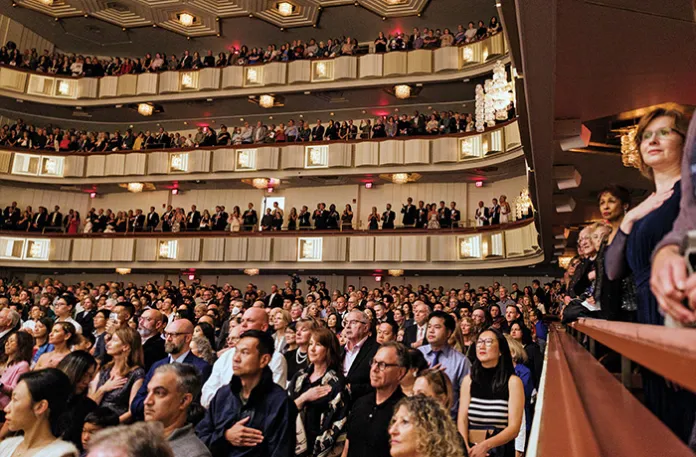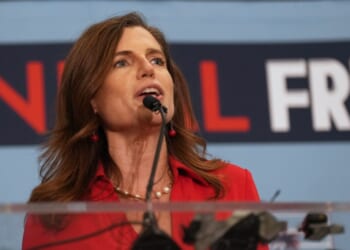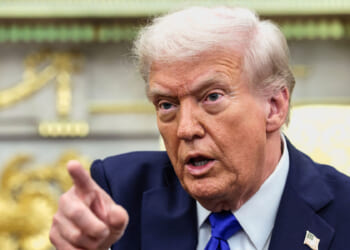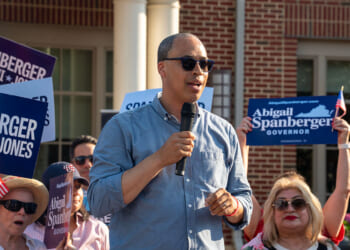Two of the nation’s most powerful newspapers, the Washington Post and the New York Times, recently portrayed special presidential envoy Richard Grenell as the villain of the Kennedy Center story. The first outlet warned of a “politicized” arts institution under his watch. The second followed with a sprawling piece titled “The Kennedy Center Crackup,” painting Grenell as a Trump-aligned provocateur who had, in its words, “brought partisanship to a place meant for art.”
But Grenell’s critics seem to have amnesia. The John F. Kennedy Center for the Performing Arts was political long before he arrived. In fact, under the Biden administration and the former Kennedy Center leadership, its programming had become a temple of ideological performance, an expensive stage for progressive sermons disguised as art.
One of the clearest examples came in July 2023, when it staged a revival of the musical 1776. The production’s own marketing made the message explicit: “A glorious multiracial cast of female, transgender, and nonbinary actors portrays the fiery founders of this country, putting history in the hands of the humans who were left out the first time around.” Even its playbill contained political directives: “Masks are optional but welcomed. We ask that you respect others’ choices and alert a staff member if you have any concerns.”

No major outlet questioned the politics of that production, or of the Kennedy Center’s heavy-handed pandemic-era messaging, or its taxpayer-funded forays into social activism. Instead, it was the appointment of a conservative reformer that prompted the press to “discover” politicization at the Kennedy Center.
When Grenell took the reins in early 2025, he found an institution on the verge of collapse. “We were careening toward bankruptcy,” said Donna Arduin, its new chief financial officer, who joined shortly after Grenell’s arrival.
“The Kennedy Center was draining cash, using money that had been raised to pay down debt in order to cover operating expenses.”
The numbers were stark. The Kennedy Center was more than $40 million in debt, and the fund intended to pay off a $30 million balloon payment due in 2030 had been quietly raided to pay staff. “We had no money in the bank,” Grenell recalled. “We were paying employees with debt reserves.”
Arduin, nicknamed the “Queen of Cuts” from her days managing finances for California, Michigan, and Florida, confirmed that previous leadership had “padded” budgets with $26 million in phantom revenue. “They were overestimating income, underestimating expenses, and misleading the board,” she said. “They even told the board there were funds in the debt service reserve that didn’t exist.”
The deception was so severe that the new team referred its findings to the Justice Department. But as Arduin noted dryly, “We’re a nonprofit, so we sit in a different world. In the private sector, this would have triggered SEC investigations.”
The Kennedy Center’s problems weren’t limited to its balance sheet. The building itself, a national memorial to John F. Kennedy, was literally decaying. “The HVAC system was ancient, the seats were breaking, and the infrastructure hadn’t been touched in decades,” Arduin explained. “They hadn’t even asked Congress for the funds they were entitled to for maintenance.”

Its “REACH” expansion, completed in 2019 for $250 million, was supposed to solve those problems. Instead, it created new ones. The sprawling, underused annex, largely empty and expensive to staff, drained resources from the main performance halls. “That money could have gone to maintaining the building, paying down debt, or improving the patron experience,” Arduin said.
Grenell’s first act as president was to demand the same accountability he brought to diplomacy. “I told every department: If you want to put on a show, it needs to break even,” he told the Washington Examiner. “No more booking productions just because they sound noble or fashionable.”
Under his new system, each program must project realistic ticket sales and secure sponsors to cover the difference if sales fall short. “If you can’t sell enough seats, you find a donor,” Grenell explained. “And if you can’t find a donor, you’re on the hook for the loss.”
The reform may sound obvious, but it’s revolutionary for a federally funded arts center that once treated deficits as acts of virtue. The era of losing hundreds of thousands on ideological shows such as 1776 is over.
Roma Daravi, vice president of public relations, calls it “commonsense management.” She noted that “the Kennedy Center’s former leadership grossly mismanaged funds, misled the board, and kept booking money-losing shows that people didn’t want to see.” The new model, she said, “asks programmers to pick shows that sell tickets — art that audiences actually love.”

Arduin added that the changes are already working: “Our development team is leaner, our base of donors is broader, and our programming is finally solvent.” At the National Symphony Orchestra gala this fall, half of the donors were new, a record-breaking influx that raised more than any previous year.
Grenell’s fiscal revolution extends far beyond ticket sales. “The Kennedy Center has incredible spaces that were sitting empty,” he said.
“We’re like a fancy hotel with rooms that should never be vacant.”
But the Kennedy Center’s 19 unions have long made rentals prohibitively expensive. “Our lighting techs, our stagehands, even our parking staff have separate unions,” Grenell said. “The costs drove clients away.” He’s now negotiating lower rates, arguing that “if you make it affordable, you’ll have three events a week instead of one. Everyone wins.”
At the same time, Grenell has embraced corporate sponsorships, something his predecessors resisted. “Corporations want to be part of the arts,” he said. “They want recognition. They want to see their name on a lounge or in a program. And they’re writing checks because they trust us not to turn every show into a political statement.”
Already, three of the Kennedy Center’s six intermission lounges have been sold to donors. Two were private deals. The third, a $25 million gift from Kazakhstan, the Washington Examiner can exclusively reveal, marks a historic first: the first international government to sponsor a space at the Kennedy Center. The new Kazakhstan Terrace Lounge will open in 2026 as a hub for cultural and diplomatic events.
Grenell sees it as the cornerstone of a larger vision. “We’re building a global arts diplomacy network,” he said. Kazakhstan’s gift came the same week it joined the Abraham Accords. The Kennedy Center isn’t just a stage anymore — it’s a platform for peace. Daravi added, “More than 50 countries have offered to bring their top artists to perform at the Kennedy Center during our America250 season, a powerful display of cultural diplomacy and support for our nation from around the world.”
Additionally, the Washington Examiner can reveal that Grenell has secured another $10 million for the refurbished African Lounge on the Opera House box tier and an additional $10 million for the Circles Lounge, both from private donors. These projects, Grenell said, “beautify the space, enhance the patron experience, and cost taxpayers nothing.”
Perhaps the most transformative piece of Grenell’s plan is his creation of an international programming division designed to work directly with embassies.
“The old staff would pick random international acts — whatever was trendy at festivals in Europe,” he said. “They never coordinated with embassies or cultural ministries. I replaced them with a team that does.”
That change has unleashed a wave of global partnerships. The Vienna Philharmonic, the Stuttgart Ballet, and Riyadh’s national orchestra are all performing at the Kennedy Center this season. Azerbaijan, whose leaders Grenell personally courted, will sponsor two major events next year.
“Every ambassador has a culture minister—and they all have budgets,” Grenell said. “We’re showing them that the Kennedy Center can be their American home.”
The result is a new model of “cultural diplomacy” — one that mirrors Grenell’s own career as a diplomat and strategist. “The arts can bridge divides where politics can’t,” he said.
Grenell’s reforms haven’t just repaired finances, they’ve restored accountability. “We are now fully transparent with our board,” Arduin said. “No more phantom budgets, no more secret funds.”
The Kennedy Center’s relationship with Congress has also improved. Sen. Susan Collins (R-ME), an appropriator who has long championed the arts, has praised Grenell’s stewardship. “Ambassador Grenell is doing a great job at the Kennedy Center,” she told the Washington Examiner. “I care about the Kennedy Center’s future and share this passion with Ric. I am glad he is investing time and energy in the programming and restoration of this historic venue and hope his efforts to expand the audience and reach of the Center yield continued success.”
Collins, who attended a production of Les Misérables at the Kennedy Center, told Grenell afterward, “You’ve taken away the elitism. There are normal people here. There are kids here. I’ve never seen this.”
That populist transformation is intentional. Grenell insists that the arts should be accessible to everyone, not just wealthy patrons or political insiders. “The way to depoliticize the arts,” Arduin says, “is to put on performances that people actually want to see.”
The press’s accusation that Grenell is “politicizing” the Kennedy Center misses the point entirely. He’s depoliticizing it by focusing on solvency and accessibility instead of ideology. Under his leadership, it has eliminated internal mask mandates, replaced staff who treated the theater as a platform for activism, and reduced bureaucratic bloat.
Grenell also tackled long-ignored labor inefficiencies. “We had entire departments signing contracts without legal review,” he said. “We replaced the legal team, rewrote the contracts, and now we actually protect the institution.” One of his first discoveries was that the Kennedy Center was locked into a loss-making deal with a musician — “$40,000 a night for two nights, almost no ticket sales,” Grenell recalled. “And no way out. That’s what we inherited.”
These fixes might sound unglamorous, but they’ve saved the Kennedy Center millions. They’ve also earned Grenell something rarer than applause: credibility.
Why, then, the outrage from the press? The answer is simple: For decades, the arts establishment has seen the Kennedy Center as its ideological fortress. Grenell’s reforms, his insistence that art must stand on its own, that ticket sales matter, that donors deserve recognition, are an existential threat to that order.
It’s easy to call fiscal discipline “political” when your own politics were never questioned. The same outlets now accusing Grenell of partisanship had nothing to say when the Kennedy Center was staging gender-theory-infused reimaginings of American history or lecturing audiences on mask etiquette.
Grenell’s approach is the opposite of political theater. It’s theater, period — made solvent, accessible, and global.
In just eight months, the Kennedy Center has gone from financial triage to renaissance. A once-elitist institution now boasts record fundraising, packed performances, and international partnerships that blend culture with diplomacy.
Grenell credits President Donald Trump for giving him the mandate to fix it. “The president said the programming was terrible and the budget was a mess,” he recalled. “He was right. And we’ve tackled both.”
Trump’s instincts proved correct: appointing a diplomat who loves both numbers and art. Grenell has restored the Kennedy Center’s purpose, not as a political playground but as a living memorial to creativity, excellence, and American leadership.
“We’re proving that fiscal responsibility and artistic freedom can coexist,” Grenell said. “We’re bringing families back to the theater, restoring our building, and showing the world what cultural diplomacy looks like in practice.”
CHARLIE KIRK MURDER ‘SET A FIRE’ IN ATTENDEES HONORING HIM AT KENNEDY CENTER VIGI
And as Kazakhstan’s $25 million terrace gift and new Abraham Accords membership demonstrate, the world is responding.
Eight months ago, the Kennedy Center was a cautionary tale. Today, under Richard Grenell, it’s a case study in how to save a national institution, not by politicizing it, but by remembering what it was meant to be: a celebration of beauty, discipline, and the best of who we are.
Bethany Mandel (@bethanyshondark) is a homeschooling mother of six and a writer. She writes and podcasts at The Mom Wars.















